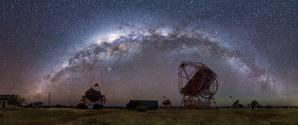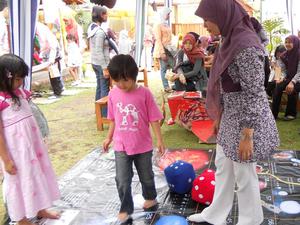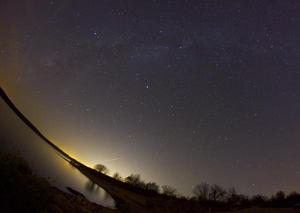Glossarbegriffe: Astronomie
Description: Die Astronomie ist eine der ältesten Wissenschaften und befasst sich mit der Untersuchung von Himmelskörpern wie Sternen, Planeten, Galaxien, Meteoren und Meteoriten. Sie erforscht auch die Erdatmosphäre, um den Planeten Erde mit benachbarten Planeten zu vergleichen. In der Vergangenheit befasste sich die Astronomie mit der Positionsbestimmungen von Sonne, Mond und Planeten, da dies für die Erstellung von Kalendern und für die Navigation wichtig war. Moderne Astronominnen und Astronomen untersuchen inzwischen auch die physikalischen Phänomene, welche die Entstehung und das Verhalten astronomischer Objekte bestimmen.
Früher war die Astronomie oft eng mit der Astrologie verbunden. Viele Menschen kennen noch immer nicht den Unterschied zwischen der Wissenschaft Astronomie und der Pseudowissenschaft Astrologie.
Die Astronomie ist eine der wenigen Wissenschaften, in der Amateure immer noch eine wichtige Rolle spielen können: Amateurastronomen haben zu vielen wichtigen Entdeckungen beigetragen.
Zugehörige Glossarbegriffe:
See this term in other languages
Term and definition status: The original definition of this term in English have been approved by a research astronomer and a teacher The translation of this term and its definition is still awaiting approval
The OAE Multilingual Glossary is a project of the IAU Office of Astronomy for Education (OAE) in collaboration with the IAU Office of Astronomy Outreach (OAO). The terms and definitions were chosen, written and reviewed by a collective effort from the OAE, the OAE Centers and Nodes, the OAE National Astronomy Education Coordinators (NAECs) and other volunteers. You can find a full list of credits here. All glossary terms and their definitions are released under a Creative Commons CC BY-4.0 license and should be credited to "IAU OAE".
If you notice a factual or translation error in this glossary term or definition then please get in touch.
Zugehörige Medien
The Eclipse Between Us, by Muhammad Rayhan, Indonesia
Bildnachweis: Muhammad Rayhan/IAU OAE
License: CC-BY-4.0 Creative Commons Namensnennung 4.0 International (CC BY 4.0) icons
Chilean observatories at home office, by Robert Barsa, Slovakia
Bildnachweis: Robert Barsa/IAU OAE
License: CC-BY-4.0 Creative Commons Namensnennung 4.0 International (CC BY 4.0) icons
Teide-Observatorium
Bildnachweis: Curd-Christian Tengeler/IAU OAU
License: CC-BY-4.0 Creative Commons Namensnennung 4.0 International (CC BY 4.0) icons
Learning Nights
Bildnachweis: Juan Pablo Botero Londoño/IAU OAE (CC BY 4.0)
License: CC-BY-4.0 Creative Commons Namensnennung 4.0 International (CC BY 4.0) icons
Milky Way Over H.E.S.S Observatory
Bildnachweis: Jianfeng Dai/IAU OAE (CC BY 4.0)
License: CC-BY-4.0 Creative Commons Namensnennung 4.0 International (CC BY 4.0) icons
Related Activities
Snakes & Ladders Game
astroEDU educational activity (links to astroEDU website) Description: Learn astronomical topics through the classic snakes and ladders game.
License: CC-BY-4.0 Creative Commons Namensnennung 4.0 International (CC BY 4.0) icons
Tags:
Game
, snakes and Ladders
Age Ranges:
6-8
, 8-10
, 10-12
, 12-14
, 14-16
Education Level:
Middle School
, Primary
, Secondary
Areas of Learning:
Game-mediated learning
Costs:
Medium Cost
Group Size:
Group
Skills:
Asking questions
, Communicating information
AstroPoetry Writing
astroEDU educational activity (links to astroEDU website) Description: An activity combining English and science to encourage students to think about the night sky to help them write a poem related to astronomy.
License: CC-BY-4.0 Creative Commons Namensnennung 4.0 International (CC BY 4.0) icons
Tags:
Art
, Creativity
, Star-gazing
, Poetry
Age Ranges:
6-8
, 8-10
, 10-12
, 12-14
Education Level:
Middle School
, Primary
, Secondary
Areas of Learning:
Fine Art focussed
, Observation based
Costs:
Low Cost
Duration:
1 hour 30 mins
Group Size:
Individual
Skills:
Communicating information
Create Your Own Astro-Music
astroEDU educational activity (links to astroEDU website) Description: Create your own music inspired by images of space.
License: CC-BY-4.0 Creative Commons Namensnennung 4.0 International (CC BY 4.0) icons
Tags:
Art
, Creativity
, Music
Age Ranges:
8-10
, 10-12
, 12-14
, 14-16
, 16-19
Education Level:
Informal
, Middle School
, Primary
, Secondary
Areas of Learning:
Fine Art focussed
Costs:
Low Cost
Duration:
1 hour
Group Size:
Group
Skills:
Communicating information
Navigating with the Kamal – Northern Hemisphere
astroEDU educational activity (links to astroEDU website) Description: How did Arabian sailors navigate at sea?
License: CC-BY-4.0 Creative Commons Namensnennung 4.0 International (CC BY 4.0) icons
Tags:
History
, Geography
, Coordinates
, Celestial navigation
, Arabia
, Kamal
Age Ranges:
14-16
, 16-19
Education Level:
Middle School
, Secondary
Areas of Learning:
Modelling
, Social Research
Costs:
Low Cost
Duration:
1 hour 30 mins
Group Size:
Group
Skills:
Analysing and interpreting data
, Asking questions
, Communicating information
, Developing and using models
, Planning and carrying out investigations
Hunting for spectra
astroEDU educational activity (links to astroEDU website) Description: Learn about light and spectra building a spectroscope with a CD!
License: CC-BY-4.0 Creative Commons Namensnennung 4.0 International (CC BY 4.0) icons
Tags:
Hands-on
, Experiment
, prism
Age Ranges:
8-10
, 10-12
, 12-14
, 14-16
, 16-19
Education Level:
Informal
, Middle School
, Primary
, Secondary
Areas of Learning:
Guided-discovery learning
Costs:
Low Cost
Duration:
1 hour
Group Size:
Individual
Skills:
Asking questions
, Constructing explanations
, Planning and carrying out investigations


















